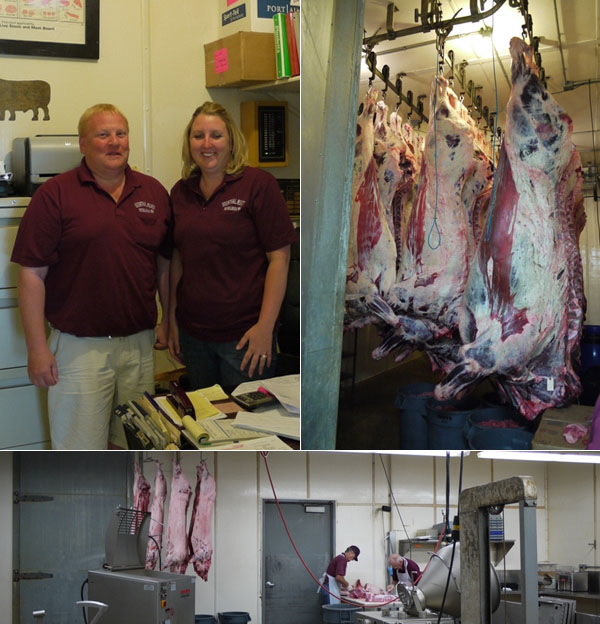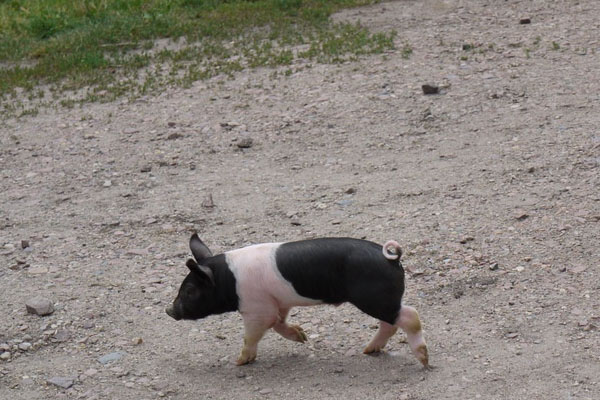
Is the US regulatory system on the brink of putting small, local meat producers out of business? Some local farms are sounding the alarm, including Fischer Family Farms of Waseca, MN.
Meat from Fischer Family Farms, including their signature applewood bacon and maple sausage, graces the menus of Twin Cities restaurants from Craftsman to Muffuletta to newcomer HauteDish. According to Tim Fischer, who runs the small pig farm with his wife, Marijo, when he visits a potential new account he just leaves a sample of these two favorites with the chef. “Chefs start out saying they’re perfectly happy with the guy who’s been supplying them for five years,” Tim says, “so I just drop off a couple samples and tell them to give me a call if they’re interested.” It’s rare that they don’t call.
Of course, chefs don’t choose Fischer Farms pork just because they personally enjoy it; they choose it because they know their customers will love it. And discriminating diners love more than just its taste; they appreciate its humane, local credentials. Based in Waseca, just an hour and a half from the Twin Cities, the Fischers feed and care for their pigs personally and give them plenty of room to move around. Then Tim brings them to nearby New Prague for slaughter and processing. From that point, Tim drives his pork products the remaining hour into town personally twice a week. Most of his distribution is within the Twin Cities; 100 percent of it is within the state of Minnesota.
As happy as the Fischers are raising their pigs, and as happy as we are eating them, Tim is worried that the whole mutually beneficial arrangement is on the point of unraveling. Why? Because the USDA is under the gun to do something, anything, about meat safety to calm the public’s nerves. Beef recalls, E. coli contamination, swine flu – you name it, and it’s gotten the public on edge about the safety of its typical main course. The USDA needs to up its game. But what the agency has chosen to do might put small farm families like Tim’s out of business.
To understand why, you first have to understand how Fischer Farms pork gets from pigs’ backs to the frying pan.

Once their pigs have grown to a market weight of about 270 pounds, Tim takes them to the slaughterhouse. A business like his can’t use just any slaughter facility – first of all, the big meat packers wouldn’t be interested in Tim’s small quantities. Second, shipping his pigs to a far-flung corner of the state where they would become part of a grim assembly line of thousands of carcasses doesn’t really square with Tim’s commitment to local, humane production. So Tim, like many small family-run livestock farmers, needs a small processor who will give the same personal attention to his pigs that he does. To meet this need, Tim works with Odenthal Meats of New Prague.
Odenthal is run by Randy and Laura, a young couple who decided to get into the processing business in 1999. Small plants like theirs are often the last remainders of a formerly robust family business, but in this case Randy and Laura have reversed that downward spiral. They started from scratch, building a plant on their own, and have had enough business from local farmers that they’ve expanded four times in the mere decade they’ve been open. Tim can’t say enough about working with the Odenthals: “Randy is an absolute magician with the meat and its preparation, and he’s very open and willing to try new things.”

Odenthal’s customers also appreciate their focus on organic processes (though the plant is not strictly an organic facility) and safety. Instead of using an ammonia wash on meat carcasses to kill bacteria, which is common at conventional plants, the Odenthals use a natural acid wash made with vinegar. All their procedures meet the USDA’s current HACCP (Hazard Analysis & Critical Control Points) guidelines, which lay out the agency’s standards for safe meat processing. To ensure compliance, the Odenthals have a computerized tracking mechanism that monitors each treatment that the meat undergoes; so, for example, if the HACCP guidelines state that it is acceptable to disinfect meat by smoking it for two minutes at 152 degrees, the tracking device measures the temperature and length of the smoking process and documents the fact that it meets the guidelines.
Using this system, Randy and Laura have never had an outbreak of contamination. But now the USDA wants to change the rules [PDF]. Essentially, the agency is asking plants to add a step. In addition to monitoring the processes that they have in place to ensure that they comply with HACCP guidelines, the USDA wants plants to monitor the results of those processes. That is, the agency wants plants to test the microbial levels of the meat itself to make sure that the processes have actually resulted in clean, safe product. (Note: The USDA could not be reached for comment by publication time.)
On the face of it, that seems to make sense. Indeed, it’s rather shocking to think that the USDA didn’t always require plants to prove not only that they’re going through the motions, but that what comes out the back end is actually safe! But talking to Randy, it’s clear why this requirement to test results is, in many cases, superfluous. “It’s been proven time and time and time again that smoking meat at 152 degrees makes it safe. Now they’re asking, how do we know that at Odenthal Meats, smoking meat at 152 degrees is safe? They want us to reinvent the wheel.” To Randy, it smacks of overkill that a plant should have to show that on this day, in this plant, with this meat and this equipment, following the scientifically verified procedure results in safe meat.
Furthermore, tests would need to be run for the very same chunks of meat at several stages of production: when raw, cooked, and frozen. If these tests had to be applied to all the types of processing that are done to all the different meats produced, the cost for small producers would be crippling. Randy estimates that for his plant and all the customers he serves, it would cost $250,000 the first time around and $30,000 annually afterward.
Could the Fischers and the Odenthals and the rest of the small livestock producers handle cost increases like these? Tim Fischer said he’d have to pass the extra cost onto his clients, the restaurants. But of course not all of his customers could handle a cost increase as big as the 30 to 40 percent that Tim thinks would be necessary, so he doesn’t doubt that he would lose business — maybe even the majority of his business.
For Tim, even that grim possibility probably represents a best-case scenario; that is, one in which Odenthal could continue to process his meat. But Randy thinks that if the guidelines are finalized in this stringent form, he’d probably have to stop processing meat for customers (like Tim) who resell it; he’d have to try to subsist on processing only for end users, like for the farmer who just brings in one or two animals to have them cut up and frozen for his own personal use. (Plants which process only for consumers and not for resale will not be subject to the new HACCP guidelines, or at least, not at first — so Randy could keep his costs under control if he limited his business to that service alone.) Again, whether he could avoid bankruptcy with just a small portion of his current business is an open question.

So the Fischers and Odenthals, along with the rest of the small, local livestock producers, are hoping that the guidelines don’t take effect in their strictest form. The good news for them is that the USDA seems now to be backing off from a strict interpretation of its initial guidance. In a fact sheet [PDF] released at the beginning of May, the agency states that if plants use treatment methods established by the USDA itself, which have been validated by conclusive scientific studies, then they do not have to go through the further step of testing to validate the results. By implication, it’s only when plants choose to use alternative treatment methods that are substantiated, say, with controversial or new scientific research that they will have to test on the back end to ensure that the meat thus treated has turned out safe after all.
Can we be sure that the USDA will proceed along this path when it issues its final guidelines? According to Ryan Cox, an expert in Meat Science at the University of Minnesota, uncertainty persists. And even if the USDA approves a more limited version of the guidelines, Cox says, “Regionally, inspectors interpret the documents differently anyway, so the danger that plants will be burdened with overtesting remains.” His own view is that better enforcement of the existing rules would do a lot more for meat safety than piling on more tests. But that is not an avenue that the USDA is currently exploring.
When all is said and done, until the USDA’s final rule comes out, no one knows for sure what it will look like. The Fischers and Odenthals, along with many others, have submitted comments to the USDA expressing their concerns. If you would like to make your voice heard, please write to USDA Administrator Al Almanza at draftvalidationguidecomments@fsis.usda.gov. The comment period ends June 19.
UPDATE, 6/10/10: The USDA released a statement [see PDF] in response to some of the questions raised in this article, stressing that the new HACCP guidance is intended to help establishments comply with existing testing requirements, not to impose new ones. The USDA is also holding a series of public meetings on this issue, starting at the end of the comment period on June 19.
Angelique Chao writes the blog From Animal to Meat.

Ai-yai-yai. Stuff like this makes me want to kick a brick wall.
I’m sure the USDA can give an 30 min oratory on why meat productions places all over the country must update their health codes but they have no idea of the hardship it is for the small farms and processors.
Btw, straight up – have any of you eaten a tray of Golden Plump drumsticks and find that it taste soo WEIRD? Must be those cholorine baths the USDA loves so much. I go to my local co-op and buy a couple small packages of meat and creatively figure out how to divi-it up for the week for a family of 5.
As I recall, this proposed rule is in response to a serious flaw in the meatpacking process. Many processors break carcasses down, and sell various parts to other processors who make consumer products. Many initial processors will refuse to sell to and secondary processor who wants them to test their meat before they ship to the secondary processor.
Here’s a New York Times story: http://www.nytimes.com/2009/10/04/health/04meat.html?_r=1
It’s certainly not a clear-cut issue.